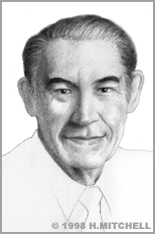Charles Kaman
Charles H. Kaman has been a leading inventor and businessman in the helicopter industry for over 50 years.
Kaman was born in 1919 and grew up in Washington, D.C. He earned a BS in Aeronautical Engineering from Catholic University, then went to work at Hamilton Standard, where he designed helicopter rotor blades for Igor Sikorsky. In 1945, at the age of 26, Kaman left Hamilton to form Kaman Aircraft Company.
Kaman had invented a revolutionary type of helicopter rotor, with aerodynamic "servo-controlled flaps" that automatically adjusted themselves to improve the safety and stability of the aircraft. After acquiring $2,000 in capital from friends, Kaman began designing his own helicopter. Two years later, in 1947, Kaman was selling his first model, the K-125.
In 1949, Kaman had his pilots "barn-storm" downtown Washington, D.C. in order to drum up business from the military. This led to a series of successful contracts for the Navy that continues to this day. For example, in 1951, Kaman designed the world’s first helicopter powered by a gas turbine. This model is now on display at the Smithsonian Air and Space Museum. In 1954, Kaman designed the first twin-turbine helicopter. In 1957, Kaman designed and operated the first remote-controlled helicopter. During Operation Desert Storm, U.S. troops used Kaman Corp.'s patented Magic Lantern mine detection system.
Kaman led the team that produced the K-MAX "aerial truck," a light-weight craft designed to carry heavy cargo for the Navy rather than people.
Kaman has won fame as a visionary by keeping his company one step ahead of the competition. He has always stressed the importance of research and development, and he still does design work himself. Kaman's helicopters are unequalled for their safety records, even under the most trying circumstances. For example, the "Husky" helicopters flew more rescue missions in Vietnam than any other aircraft. Kaman Corporation now enjoys over $1 billion in annual revenue with projects that include the wing design of the Boeing 777.
Other Kaman inventions used in various industries include artificial intelligence systems, maintenance-free bearings, and cleaner-burning electromagnetic motors. In addition, Kaman invented the first composite material guitar, the Ovation acoustic guitar. He also painstakingly bred a strain of German shepherd to be ideally suited for work as guide dogs for the blind, and with his wife, he co-founded New England’s only guide dog school, Fidelco.
Charles Kaman won numerous awards for his work as an inventor and philanthropist, including the Distinguished Public Service Medal in 1995, the National Medal of Technology in 1996, and the Wright Brothers Memorial Trophy in 1997.
Kaman passed away on January 31, 2011.


